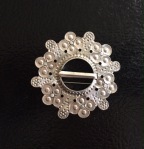
THE SILVER BROOCH
By Kaja Weeks
When my mother was a young girl growing up during the late 1920s and early 1930s she lived in Eesti, a free land, dotted with islands, its northern coastline a curly ribbon on the Gulf of Finland. Western Estonia opens to the Baltic Sea. Her seaside hometown, Pärnu, on its own glittering inlet of the softest white sand beaches, murmurs with endless surf, coastal pinewoods-and- meadows. The harbor, a longtime merchant port, and famous restorative spas have always infused a cosmopolitan air, too. There is a saying, “If you let Pärnu, with its sun and sea breezes, into your system, your cloud of worries will waft away,” and certainly my mother’s forehead would always smooth out even as she sighed and spoke of her “good growing years” there.
There is a photo of my mother and her cousin, Helga, who visited from inland in the summers. They are both wearing stylish casual, fitted dresses, mother’s coiffure flapper-like wavy, a small white sailor hat perched on Helga’s head. They are sitting fountain-side at the famous Pärnu Mudbaths and Spa. It’s an elegant neo-classical building co-designed by the renowned architect Olav Siinmaa with whom Mother was soon to get her first job. She was sixteen, still innocent, unknowing of all the horrors that war, deadly occupations, fleeing and life’s turns would bring.
But this was around the time she acquired the silver brooch, which I now hold in my hand. The year is 2016, mother’s earthly life is past and I have so little, really, to connect to the person she once was. Though she raised me and lived well into her nineties, I felt as if I was continually seeking her core – so ephemeral. It’s as if her historic destiny endowed cloaks of spectacular resolve and stoic endurance (in a crisis she once declared, “I am the keeper of my own soul,” when I proposed help) and tactics worthy of an institution for preserving the dignity and culture of her lost world. But it snatched away the budding young girl who had once loved her life in a simple, seaside town in a free land; Even from inside, where we get to create and hold our woven selves, I sensed a lost space where it should be. I am haunted by and grieving of that loss for her, probably wishing to protect both of us from what followed, its inter-generational rubble. Sparsely told stories from her childhood and youth are well-guarded in my mind, enhanced over the years with scarce photos and then with world-wide-web image searches, scouring of maps, finally visiting myself and walking the ground she walked, breathing that highly oxygen-rich sea air – trying to re-create a world with a legacy that holds the pearls of mother.
Her brooch is not domed or smooth, but a special “Pärnu-style” flat cast with a jagged coastline shape and interior adorned by flower motifs – one for which the city was already a unique site of creation in the previous century. I only remember from her that it was a gift, possibly from her godmother for her “Kaubanduskooli” (Business Trade High School) graduation from which she landed the coveted city hall position with architect Siinmaa. It must have been a cherished item. Not that many years later, the autumn she fled, the second Soviet onslaught had breeched the border, while retreating Nazis blew up myriad buildings and bridges. Pärnu was burning, lit from above with pale columns of aerial bombings; flames raced along crowns of coastal trees. In the space where her high school had stood, ruins smoldered. Leaving her homeland forever, she carried that brooch with her few belongings. Decades later she quietly gave it to my then teenage daughter.
Now I hold this brooch that I’ve taken to the jeweler to be cleaned, polished, and the clasp repaired, secretly restoring it for my daughter’s approaching wedding. It was completely darkened when I brought it in, but when I retrieved it the jeweler was smiling with pride. He had worked hard to clean all the tiny crevices. “It’s silver,” he said with delight. Sitting on my bed, I turn the gleaming piece over in my hand. My mothers initials (as I have always known them) have always been visible in what I recognize as my father’s scratchy, invasive style, one that he enacted with all my things, as well – possessions possessed. But now I notice something that eluded my eye before, something revealed by removing the shades of time. Delicate lines form a year and shape letters. It takes me a moment to place them, and then I am flooded with sadness and joy: “SK” – my mother’s maiden monogram! Along this untarnished silver I rub my finger on such tiny lines, attach, and hold SK, born in a free land by the sea.
copyright © 2016 by Kaja Weeks
The Silver Brooch by Kaja Weeks was first published in The New Directions Journal, Fall 2016
